Still having trouble deciding what to wear for Halloween this weekend, dear readers? Well, you’re in luck: I’ve brought along some inspiration today just for you! During World War II, Princesses Elizabeth and Margaret were tucked away at Windsor Castle for safekeeping. Every year, they put on pantomimes with elaborate costumes to entertain themselves and the rest of the castle’s residents. Just check out some of these outfits!
The Top Ten: Royal Opals
October babies, let’s face it: you’ve got a pretty cool birthstone. Opals come in a variety of colors, and often they look like they’re literally glowing from within. Most of the world’s opals are mined in Australia, so it’s no surprise that it’s also the country’s national gemstone. Royals have been attracted to opals for centuries, from the “Burning of Troy” opal given by Napoleon to Josephine all the way to the present day, though many royal collections lack major opal pieces. Today, we’re running down ten of the most intriguing opals in royal collections past and present.
10. Queen Letizia’s Pink Opal Earrings: Letizia’s jewelry collection includes the “Dinah” pink opal earrings from Tous, a Barcelona-based jewelry company. (See a closer image of the earrings here.) The new Spanish queen prefers extremely delicate, minimalist jewelry, so these drop earrings are actually some of the more substantial in her jewelry box. The earrings retail for $540 and can be purchased here.
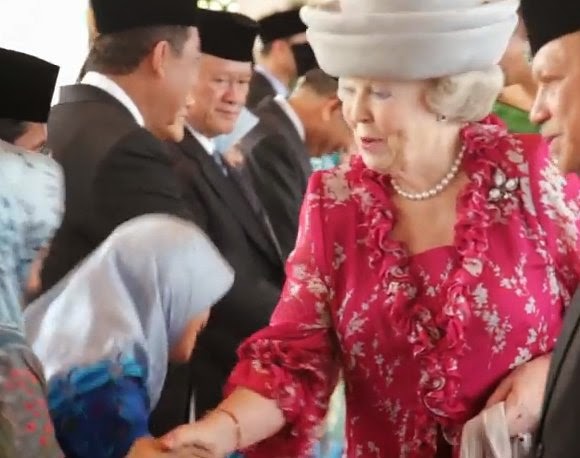 |
| (source) |
9. The Dutch Opal Flower Brooch: The Dutch royal family’s jewel foundation includes a 19th-century flower brooch set with milky opals and a single ruby. Queen Juliana wore the piece during the 1970s, and Princess Beatrix brought it out of the vaults during the final months of her reign for a state visit to Brunei. (Read more at John’s website.)
8. The Australian Opal Spray Brooch: Since opals are Australia’s national gemstone, and Elizabeth II is the Queen of Australia, you’d be correct in assuming that her jewelry box included several opals. This one was one of her wedding gifts in 1947, from the Returned Sailors, Soldiers and Airmen Imperial League of Australia. It features black opals set in gold.
7. Crown Princess Mary’s Opal Pendant: To mark the first birthday of Prince Christian of Denmark (an October baby!), a Sydney-based jeweler reportedly presented the Australian-born Crown Princess Mary with an opal pendant necklace. (The gift apparently came with jewelry for Crown Prince Frederik as well: a set of opal cuff links.) I don’t think Mary has ever worn this necklace in public; if she has, please point me toward pictures!
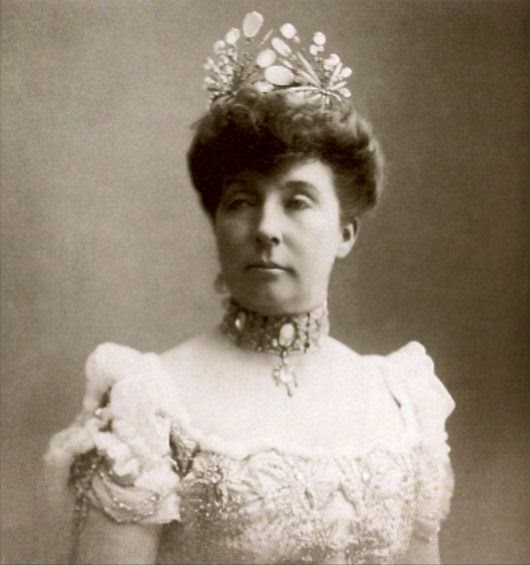
6. Princess Marie’s Opal Parure: In the late nineteenth century, Princess Marie d’Orléans, the wife of Prince Valdemar of Denmark, owned a striking parure of jewels set with opals and moonstones. The opal tiara ended up with her son, Prince Viggo; it was substantially remade to look like a more traditional tiara and worn by his wife, Eleanor. More recently, it was worn by Viggo’s daughter-in-law, the late Countess Ruth of Rosenborg. The choker that Marie wears in the portrait above is owned today by Chantal d’Orléans.
5. The Dutch Fire Opal Brooch: Princess Beatrix of the Netherlands has a collection of private jewelry separate from the family’s jewel foundation. It includes a set of fire opal and diamond jewels: a bracelet, a brooch, a ring, and a pair of earrings. Fire opals are an especially appropriate stone for the Dutch royals, as they’re often found in shades of yellow-orange. Beatrix sometimes loans the set to Queen Maxima, who wore them to an awards ceremony last year. (As always, more at John’s website.)
4. Queen Mercedes’s Opal Ring: Just in time for Halloween, it’s a cursed opal! For their wedding in 1878, King Alfonso XII and Queen Mercedes of Spain (pictured above) were given an opal ring by one of his former mistresses. The story goes that Mercedes (probably not having been clued in about the giver’s former relationship with her husband) wore the ring — and then she died. Alfonso passed along the ring to his grandmother, Queen Maria Cristina — and then she died. Next, he gave the ring to his sister, Infanta Maria del Pilar — and then she died. Eventually Alfonso puts the ring on himself, and you guessed it — he died. Of course, Mercedes had typhoid fever even before her marriage, Maria Cristina was 72, and Alfonso had tuberculosis and dysentery. But maybe it’s for the best that the family reportedly gave the ring to Madrid’s cathedral — you know, just in case.
3. Queen Alexandra’s Opal Parure: When Princess Alexandra of Denmark married the Prince of Wales in 1863, her new mother-in-law, Queen Victoria, gave her a suite of opal and diamond jewels. The set included a cross pendant, a set of three brooches, a pair of earrings, and a bracelet (which Alexandra wore on her wedding day). The late Prince Albert had apparently drawn the designs for the set, which was made by Garrard. But Alexandra was not a fan of opals — a novel by Sir Walter Scott had popularly depicted them as a symbol of bad luck — and some have suggested that she had these pieces reset after Victoria’s death. I’m not sure that’s the case — the sources I have aren’t clear on the pieces’ fates — but either way, Alexandra’s opals don’t seem to be hanging about in royal hands these days.
2. The Oriental Circlet: Alexandra didn’t stop her opal makeover with her own jewels — she also had other opal pieces in the royal collection reset with Burmese rubies. Among these were Queen Victoria’s Oriental Circlet, designed by Prince Albert and set with opals, one of his favorite gemstones, as well as a necklace and a pair of pendant earrings. All of these formerly-opal jewels remain with the royal family today.
1. The Andamooka Opals: During her tour of Australia in 1954 (pictured above), Queen Elizabeth II was presented with an astonishing set of opal jewels. The necklace and earrings were set with opals that had been discovered in the Andamooka opal fields; the enormous opal in the necklace weighs more than 200 carats. Elizabeth wore the set once during the tour, pairing it with Queen Mary’s lover’s knot tiara — and then put it in the royal vaults. I can see that it’s perhaps not to the Queen’s taste — the necklace especially is an unusual modern piece — but surely there’s someone in the family (*cough* Kate? *cough*) who could take this set out for a spin.
Queen Ena’s Turquoises
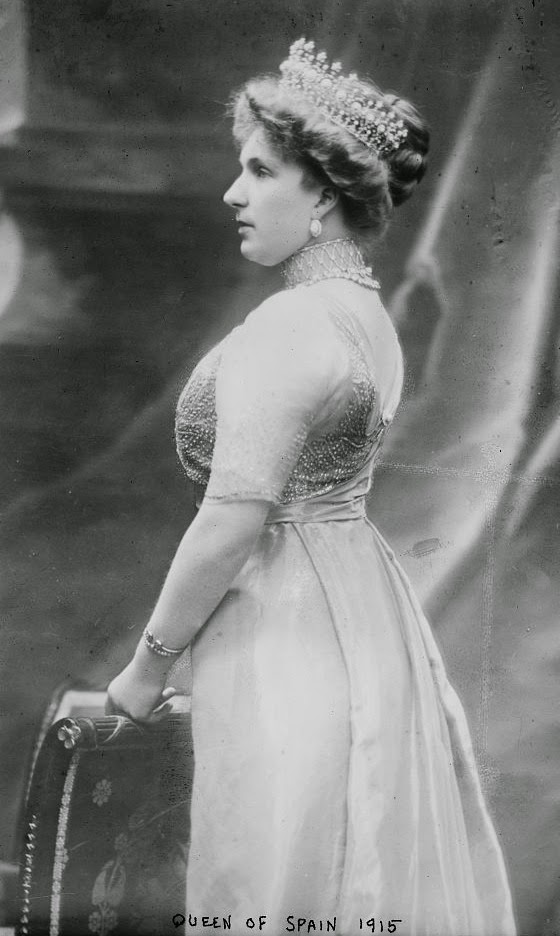
Queen Ena wears her turquoise tiara, necklace, and earrings (source)
Lots of the fantastic jewelry from the collection of our Magpie of the Month, Queen Ena, is well known, especially the pieces that various family members inherited and continue to wear today. But today, we’re talking about her small cache of turquoise jewelry — pieces that have managed to fall off the radar entirely in the years since Ena wore them.
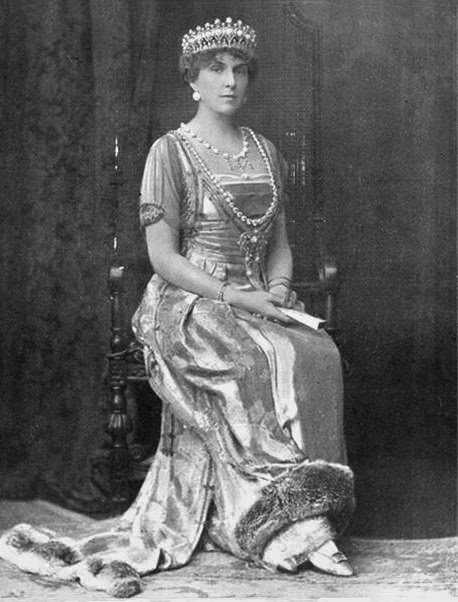
Queen Ena wears her turquoise tiara, necklace, and earrings (source)
When Ena married the Spanish king in 1906, her uncle and aunt — King Edward VII and Queen Alexandra — were on the throne in Britain. The illustrated list of Ena’s wedding gifts includes a present attributed to them: a turquoise necklace and earrings. (It’s number ten on the list, which you can see here.) Above, Ena wears the turquoise necklace and earrings with a striking turquoise tiara. It’s commonly called a turquoise “star tiara,” because the top row of the piece features small stars above the central turquoise buttons.
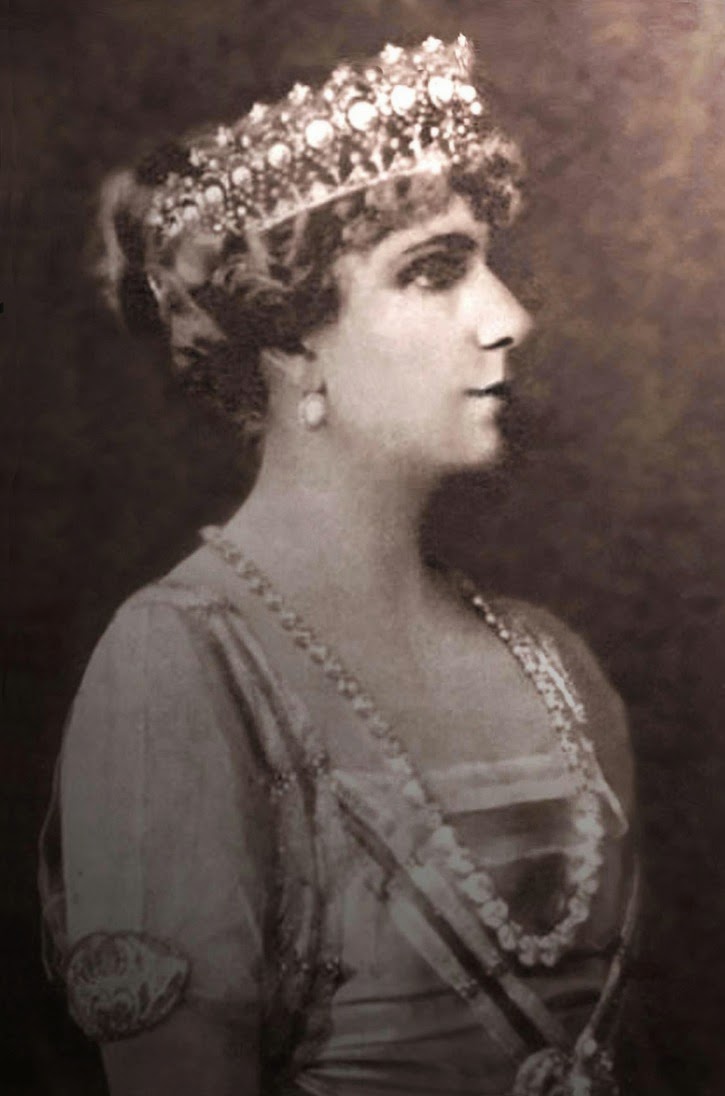
Queen Ena wears her turquoise tiara and earrings (source)
Some have speculated that the turquoise star tiara was also a gift from Bertie and Alexandra, because Ena was often photographed wearing it with the necklace, the earrings, or both. But to my knowledge, the provenance of the tiara has never been specifically identified.
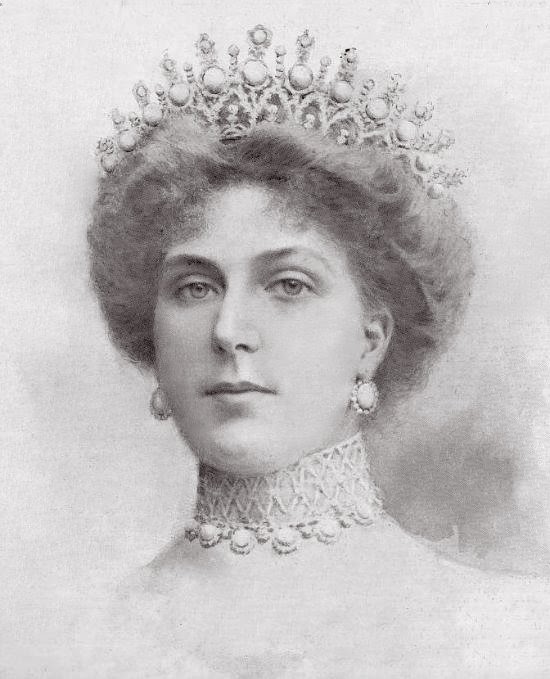
The turquoise buttons in each piece do appear to be of a similar size and design, so it’s certainly possible. The king and queen had given another of their nieces — Margaret of Connaught — a tiara for her wedding the previous year, so it wouldn’t surprise me if their gift to Ena was a complete turquoise parure.
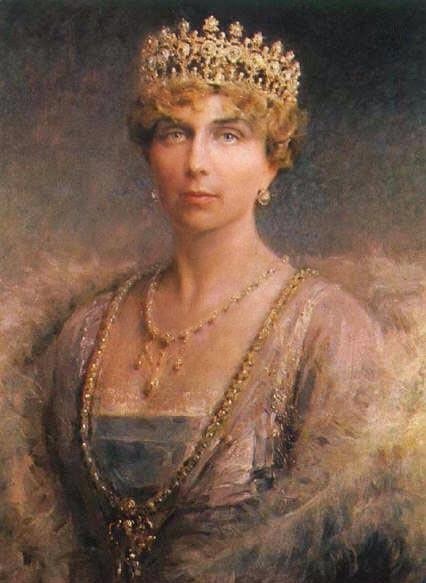
Queen Ena painted in her turquoise jewels — rendered here as diamonds (source)
The fate of the entire turquoise suite is also a bit of a mystery. Ena was painted in the suite — you can see above, however, that the artist decided to paint the jewels as diamonds instead — but its whereabouts today are not known. Queen Ena’s life was a tumultuous one — she lived through assassination attempts, war, exile, the deaths of three of her children, and the breakdown of her marriage — and she did sell some of her jewels along the way. It’s certainly possible that these turquoise jewels met that particular fate.
In fact, we know for certain that Ena sold another turquoise tiara from her collection. During their engagement, Alfonso gave Ena a turquoise and diamond tiara, made by Chaumet. It featured fleur-de-lys motifs, the symbol of the Borbon dynasty. Ena ended up replacing the turquoises in this tiara with diamonds — perhaps a sign that she wasn’t ultimately that fond of the gemstone? She was painted wearing the tiara by Tosti Russell in the late 1930s; you can see her posing with the painting in the photograph above, taken in 1938. But in the end, Ena decided to sell the Chaumet tiara. Perhaps her other turquoises went on the auction block as well?
- « Previous Page
- 1
- …
- 794
- 795
- 796
- 797
- 798
- …
- 857
- Next Page »